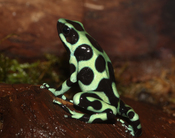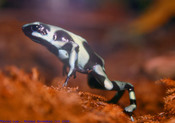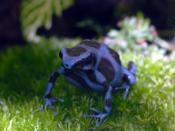Scientist have actually found a poisonous frog that takes a toxin from its prey and then changes the chemical to make it much more deadly. There are at least three species of what are called the Dendrobates frogs. They range from 4-to-5-centimeters long and they can be found in the New World tropics. The frogs modify an alkaloid to create one that's about five times as poisonous. The poison, one of a class called pumiliotoxins, ends up as a protective agent in the frogs' skin.
It's an important thing, showing how chemistry connects the life of one organism to another. Even though scientists have found that some animals and insects other than frogs customize a basic toxin for different purposes, they haven't found any other examples of improving a defensive weapon. Finding that some frogs change the toxins they have eaten came as a surprise to the scientists who were studying dart-poison frogs, which belong to the family that includes Dendrobates.
Frogs in three other families in South America, Australia, and Madagascar also carry poisons in their skin but when zoos and aquariums raise these supposedly deadly creatures, frogs from all but one Australian genus grow up harmless.
Two scientist were working with an alkaloid called pumiliotoxin 251D, one of the skin toxins of the frog Dendrobates auratus. The scientists produced both the form of the alkaloid found in nature plus a mirror-image form. The scientist dusted the formula on to some termites and fed them to the captive frogs. When the scientists later analyzed the skins of the frogs who were fed the spiced insects, about 80 percent of the natural form of 251D had been converted to another toxin, called allopumiliotoxin 267A but the unnatural form of 251D showed up unchanged in the frogs skin.
This discovery...



Interesting
Pretty good job. Interesting that animals can do that!
3 out of 3 people found this comment useful.